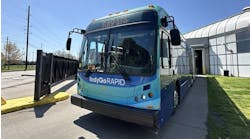Metro Transit, the primary public transportation provider in the Minneapolis/St. Paul metropolitan area, operates buses, light rail and commuter rail within a region of 2.9 million residents. Its bus fleet includes 686 40-foot buses, 166 articulated buses and 36 coaches. Average weekday bus boardings are 230,000 at more than 12,000 bus stops in a service area of 907 miles. Of its nearly 2,800 employees, more than half — 1,452 — are bus operators.
Metro Transit’s primary focus has always been providing safe, reliable transportation options. Its safety record for National Transit Database reportable collisions for 2008-2011 is far below those for the top 30 U.S. transit agencies, its peer agencies and those of comparable bus operations within several larger providers.
However, in 2009, following two fatal bus-pedestrian collisions, the agency’s Bus Safety and Bus Transportation departments began collaborating on several initiatives to reduce collisions and enhance overall safety performance.
A comprehensive framework of education and outreach laid in 2009 and 2010 has led to improvements in customer perceptions of safety, a 6.5 percent annual reduction in collisions and a $582,282 annual savings in risk management claim payments.
Better Operator Education
A “Look & See” campaign was developed in 2009 and highly promoted in 2010 to all garage employees. The campaign with a bold Look & See graphic saturated the bus operators’ work environment — from the break room to the bay — with reminders to be aware of their surroundings while in service.
Look & See stickers were initially placed inside buses on the street-side frame of bus windshields at one operating garage as a test. This frame creates a “blind spot” or visual obstruction that the bus operator needs to look around, especially when turning at an intersection. Feedback from bus operators on the stickers was positive so Look & See stickers were placed on every bus in the system as a constant reminder.
The Look & See campaign had several phases, each focusing on a different facet of operational safety: pedestrians, bus stops and bicycles. The Look & See pedestrian campaign involved a series of weekly operator bulletins, each using photos and simple messages to raise awareness of pedestrians among bus operators and to remind them to use one of the five Safety Keys. Safety Keys is a nickname of the Smith System, and is the cornerstone of Metro Transit’s bus operator training program. Smith System training provides advanced driving techniques for space cushion driving and collision avoidance. To place added importance to the message, these bulletins were handed to bus operators by transportation management.
The bicycle Look & See phase used a short video created by Metro Transit’s Instruction Center and Safety department playing off the concept of “ghost bikes” that are often placed at the site of bicycle fatalities. Metro Transit Safety obtained unclaimed bicycles from the city of Minneapolis then worked with the Maintenance Department to carefully run over each bicycle with a bus. Maintenance painted each bicycle white then designed wheeled stands. The ghost bikes, with Look & See graphics on them, were placed in bus operator break rooms and moved around to other locations inside the bays. They were a sobering but effective reminder of the importance of staying alert.
One of the messages used in the Look & See campaign was Rock “n” Roll to Look & See. It was based on the “rocking” in the driver’s seat and rolling your body to see past obstructions. Almost life-size cut-outs of Elvis were decorated with Look & See logos and placed in the bus operators’ break rooms.
In 2012, Metro Transit also began working with the University of Minnesota’s Center for Transportation Studies — a frequent collaborator on performance and safety enhancements — on left-turn pedestrian collision research using a simulator. This analysis is ongoing.
Reducing Distracted Driving Behaviors
In 2005, using a cell phone while operating a bus was changed from a Class B to a Class A violation. In late 2009, Metro Transit beefed up its policy, changing it to require operators to have electronic devices turned off and stowed off the body while operating a bus. In addition, it began reinforcing the severity of this violation with posters at work sites.
Also, beginning in 2009, Safety began a campaign to ensure that all bus operators attend Safety Keys training — which incorporates a distracted driving video — at least once every three years.
One-third of the bus operators would be trained each year. This was accomplished ahead of schedule and by 2010, the vast majority of bus operators had participated in the Safety Keys refresher course within the past three years.
In 2011, Metro Transit Safety held Health & Safety fairs at each operating facility. Staff borrowed a simulator the American Automobile Association uses for training, giving operators an opportunity to test-drive the module and experience how distractions affect reaction time.
In 2012, a Transportation Safety Institute-certified class on distracted driving “Curb your Distractions,” was added to annual operator training.
This course was originally developed by TSI as an online class that required user accounts. While an online course worked well for the smaller rail operator workforce at Metro Transit, there were significant logistical barriers to having nearly 1,500 bus operators log into the training from their own computers with an individual user account. Metro Transit Safety and TSI collaborated to develop a classroom version of the training, where Metro Transit acted as the pilot property for this implementation. As a result of the teamwork, Metro Transit was able to certify each of its operators in the TSI course.
As a result of the expanded education efforts combined with measured enforcement, customer complaints regarding distracted driving have dropped from 0.123 per 100,000 boardings in 2009 to 0.019 per 100,000 boardings. There were 19 violations in 2009 and unfortunately, the same number in 2012. Metro Transit has been firm but fair in enforcement of its policies and sadly, people who ignore the rules have lost their jobs.
Improving Customer Awareness of Safety
In recent years, Metro Transit has used the philosophy in customer communications that “safety is a shared responsibility.” In 2011, a new campaign told customers to “Stay out of the Zone” around the bus for safety.
In 2012, a new campaign focused on keeping customers away from the curb and warned customers to “Stay safe/Don’t chase.” Through bus wraps, bus-side ads, interior car cards, shelter ads, online banners and onboard newsletters, Metro Transit alerted customers to the perils of running after a bus after it has left a stop.
Addressing Winter Road Performance
Minnesota is known for challenging winter weather, and knowing how to operate safely in snow is absolutely critical for Metro Transit operators. To help bus operators address this challenge, Metro Transit Safety created a winter driving training video, “What Would You Do?” The video is divided into chapters: Getting Prepared, Bus Stops, Highways and Articulated Buses. The 17-minute video was shown to all bus operators in 2010. It can be shown in whole or by chapter for targeted retraining. In addition, all new bus operators took part in a safety conference prior to the winter season.
At the same time, the maintenance division addressed issues with articulated buses becoming stuck in snow. Tires with more aggressive tread were installed on the drive shafts of articulated buses and bags of sand were placed on each of the buses to help add traction when rear wheels are snowbound.
Reaching Out to the Growing Bicycle Community
The popularity of bicycling has exploded nationally in the past 20 years and in the Twin Cities of Minneapolis and St. Paul, the trend is no different if not more pronounced. In fact, "Bicycling" magazine in 2012 named Minneapolis the No. 2 on its list of the most bike-friendly cities in the country.
With bicyclists of many skill levels — from the experienced rider to the novice two-wheeler — sharing the roadways with them requires bus operators to understand the rules that apply to bicycles and Metro Transit policies for safe operation around bicycles.
In 2009, Metro Transit Safety and its Instruction Center produced a video (“Patience”) that showed operators how to interact effectively with bicyclists, addressed the policy for following distances and gave other tips for safe operation along bicycles in mixed traffic.
Once again, safety is a shared responsibility with cyclists. To this end, Metro Transit Bus Transportation in 2011 set up a Life Behind the Wheel clinic and invited area bicycling enthusiasts to attend. At the event, bicyclists were able to sit in a bus operator’s seat and experience what an operator can — and cannot — see when in service. This is an idea that any agency can and should adopt to forge better relationships with the bicycling community.
Customer Recognition of Improvements in System Safety
Metro Transit conducts onboard customer research every two years to gauge customer perceptions of service performance and other aspects of the transit experience.
In 2012, the performance measure “Drivers operate vehicles in a safe and responsible manner” received one of the highest scores, 4.26 of a possible 5. This is up from a score of 4.16 in the 2010 research.
Results
Customers have recognized an improvement in system safety performance. Collision statistics show that Metro Transit’s efforts in 2009-2010 continue to bear fruit in 2011-2012 and beyond. Metro Transit Risk Management numbers show that the number of collisions fell from an average of 967 in 2009-2010 to an average of 904 in 2011-2012 — a decrease of 6.5 percent.
In 2009-2010, Metro Transit was paying roughly $1.6 million in risk management claims related to collisions each year. As a result of the system safety programs implemented, by 2011-2012, claim amounts had dropped by more than 70 percent to $419,000. Not only had the number of collisions declined but also the severity. The average cost per collision dropped 72 percent, from an average of $1,638 in 2009-2010 to just $463 per collision in 2011-2012.
Conclusion
These results demonstrate the effectiveness of using a system safety approach to collision reduction. Bus Operations, Bus Maintenance, Training and Marketing worked together in a comprehensive effort of education, equipment improvement and outreach that made it possible. And the good management practice of measured enforcement was a needed component as well.
This program relied on readily available tools, such as Safety Keys from the Smith System of defensive driving, and the creativity of Metro Transit staff. Metro Transit is happy to share any of its training and promotional materials, including the video “Winter Driving: What Would You Do?” and our Look & See promotion logos and bulletins.
This program was innovative in its delivery, commitment from management and community involvement — all leading to a sustained reduction in collisions. Customer campaigns were kicked off during other promotional events. It took a major commitment from management to make this a sustained effort.
All of this can be summed up in one of Metro Transit’s Guiding Principles: “We provide a safe and secure environment for our customers, community and employees through consistent training, enforcement and allocation of resources.” Put another way, safety is the cornerstone of what we do.




